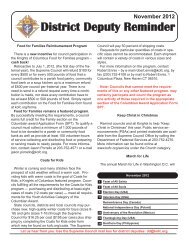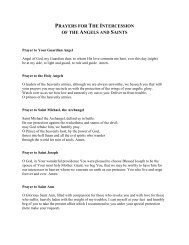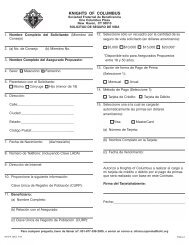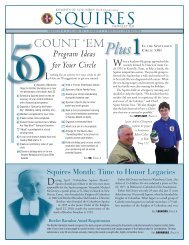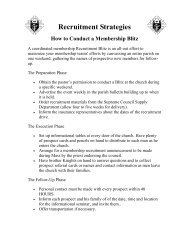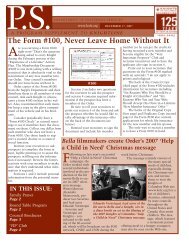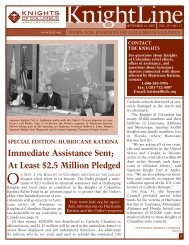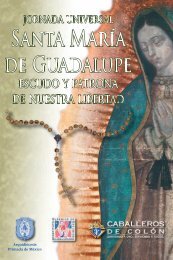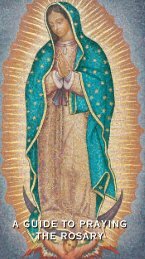Revelation: - Knights of Columbus, Supreme Council
Revelation: - Knights of Columbus, Supreme Council
Revelation: - Knights of Columbus, Supreme Council
Create successful ePaper yourself
Turn your PDF publications into a flip-book with our unique Google optimized e-Paper software.
white hair represents eternity; in Daniel it was the quality <strong>of</strong> the “ancient <strong>of</strong><br />
days” (God), but John, who is compressing the picture given by Daniel,<br />
simply ascribes it to the Son <strong>of</strong> Man, Who is also God. The rest <strong>of</strong> the<br />
description in vv. 14-15 is likewise borrowed from Daniel, but from another<br />
vis ion, that <strong>of</strong> 10:5ff. The voice like the voice <strong>of</strong> many waters is from Ezekiel 1:24,<br />
43:2, etc. The seven stars in the Son <strong>of</strong> Man’s right hand are explained later,<br />
and the sharp two-edged sword in His mouth is a common enough symbol for<br />
the word <strong>of</strong> God.<br />
Thus John has communicated through this imagery, that his rev elation is<br />
from the One Who is both God and Man, the Messiah, the Redeemer, Who is<br />
Lord <strong>of</strong> history and <strong>of</strong> His Church. And this is confirmed by the words <strong>of</strong> the<br />
Son <strong>of</strong> Man in the last verses <strong>of</strong> this first chapter. Whether the angels <strong>of</strong> the seven<br />
churches is a further symbol <strong>of</strong> the Bishops <strong>of</strong> the churches to which the letters<br />
are addressed, as seems quite likely, or means simply the angel which God has<br />
appointed to watch over His church, cannot be determined.<br />
The Form <strong>of</strong> the Letters<br />
When we look at the letters to the churches in the next two chap ters, we<br />
see that they all follow a set form. There is a set introduc tion, “To the angel <strong>of</strong><br />
the church at – write…” Then follows the message, divided into two parts, the<br />
first <strong>of</strong> praise, the latter <strong>of</strong> censure. At the end, another set form di vided into<br />
two parts: (a) “He who has an ear…”; and (b) “He who overcomes…” As a<br />
further mark <strong>of</strong> John’s style, it could be re marked that in the first three <strong>of</strong><br />
these letters the concluding formula (a) precedes (b), but in the last four (b)<br />
precedes (a). This is as we pointed out in a preceding article, the custom <strong>of</strong> the<br />
apocalyp tic style, to divide sevens into groups <strong>of</strong> four and three. Usually John<br />
follows the four-three arrange ment rather, than as here, the three -four. Thus in<br />
ch. 6, the first four <strong>of</strong> the seven seals are broken, and later the last three. Also<br />
in ch. 8 the first four <strong>of</strong> the seven trumpets sound as a group, and afterwards<br />
the last three.<br />
In taking the letters to the churches as a group, first <strong>of</strong> all, we get a better<br />
idea <strong>of</strong> what John is trying to say. There are, as is obvious, details in the letters<br />
which pertain only to the churches to which they are addressed, and which are,<br />
therefore, the reason these churches were chosen. John has things to reveal <strong>of</strong><br />
praise and blame for the Christians <strong>of</strong> his day. At the same time, the<br />
- 28 -




